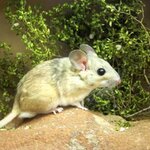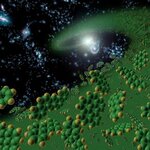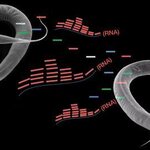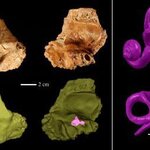Evolution

Woodrats lost their ability to eat toxic creosote bushes after antibiotics killed their gut microbes. Woodrats that never ate the plants were able to do so after receiving fecal transplants with microbes from creosote-eaters, University of Utah biologists found.
The new study confirms what biologists long have suspected: bacteria in the gut – and not just liver enzymes – are "crucial in allowing herbivores to feed on toxic plants," says biologist Kevin Kohl, a postdoctoral researcher and first author of a new paper in Ecology Letters.
A captive desert woodrat, also known as a packrat,…

A new paper in Astrobiology says we will need to look to oceans to find life on Earth-like planets. Most computer simulations of habitable climates on Earth-like planets have focused on their atmospheres, but as is easily seen on Venus, the presence of oceans is vital for optimal climate stability and habitability.
Their model simulated pattern of ocean circulation on a hypothetical ocean-covered Earth-like planet. They looked at how different planetary rotation rates would impact heat transport with the presence of oceans taken into account.
Professor David Stevens from the University…

The relics of ancient viruses preserved in the genomes of 38 mammal species have provided insight into cancer’s ‘footprint’ on our evolution.
Viral relics are evidence of the ancient battles our genes have fought against infection. Occasionally the retroviruses that infect an animal get incorporated into that animal’s genome and sometimes these relics get passed down from generation to generation – termed ‘endogenous retroviruses’ (ERVs). Because ERVs may be copied to other parts of the genome they contribute to the risk of cancer-causing mutations.
A team from Oxford University, Plymouth…

Evidence from human famines and animal studies suggests that starvation can affect the health of descendants of famished individuals, but how such an acquired trait might be transmitted from one generation to the next?
A new study involving roundworms finds that starvation induces specific changes in small RNAs and that these changes are inherited through at least three consecutive generations, apparently without any DNA involvement. The paper in Cell offers new evidence that the biology of inheritance is more complicated than previously thought.
The idea that acquired traits can be…

What 'separates us from the animals'. as the saying goes?
Not a lot. We're all animals, of course, but among primates there is an easy-to-spot difference: Humans tend to walk in lateral sequences, a foot down and then a hand on the same side and then moved in the same sequence on the other side, while apes and other non-human primates walk in a diagonal sequence, in which they put down a foot on one side and then a hand on the other side, continuing that pattern as they move along.
What does that mean? It means quadripedalism, such as among the five Turkish siblings profiled in the…

Recent re-examination of a 100,000 year old early human skull using micro-CT scans has revealed the interior configuration of a temporal bone thought to occur only in Neanderthals.
The fossilized human skull was found during 1970s excavations at the Xujiayao site in China's Nihewan Basin. Since Western Europe and Eastern Asia are a long way apart, "The discovery places into question a whole suite of scenarios of later Pleistocene human population dispersals and interconnections based on tracing isolated anatomical or genetic features in fragmentary fossils," said study co-author…

Evolutionary adaptations have allowed Tibetans to have no trouble living at 13,000 feet, but how they became able to conquer the harsh environment of hypoxia has long been a mystery.
Genetic studies on Tibetans' adaptation to high altitude indicated that a hypoxia pathway gene, EPAS1, had the most extreme signature of positive selection in Tibetans, and was shown to be associated with differences in hemoglobin concentration at high altitude. In a recent study, researchers re-sequenced the region around EPAS1 in 40 Tibetan and 40 Han individuals, and found this gene in Tibetans harbored a…

A small tree or shrub found in mountainous Central and South American rainforests has a most unusual relationship with the birds that pollinate its flowers, according to a new study - the plant known as Axinaea offers up its male reproductive organs as a tempting and nutritious food source for the birds.
As the birds seize those bulbous stamens with their beaks, they are blasted with pollen by the flowers' complex "bellows" organs. The birds then deliver that pollen to receptive female floral organs as they forage on.
Food bodies situated on male reproductive organs are otherwise only known…

Many traits unique to humans are thought to have originated in the genus Homo between 2.4 and 1.8 million years ago in Africa.
What are the evolutionary factors that drove them?
A large brain, long legs, the ability to craft tools and prolonged maturation periods were all thought to have evolved together at the start of the Homo lineage as African grasslands expanded and Earth's climate became cooler and drier. However, new climate and fossil evidence analyzed by a team of researchers suggests that these traits did not arise as a single package. Rather, several key ingredients once thought…

The dominant hypothesis for the reason that northern Europeans developed light skin is that they needed to absorb more ultraviolet (UV) light to make more vitamin D, which is vital for healthy bones and immune function.
Not so, says a U.C. San Francisco dermatologist. Peter Elias, MD, and colleagues write in Evolutionary Biology that changes in the skin's function as a barrier to the elements made a greater contribution than alterations in skin pigment in the ability of northern Europeans to make vitamin D. They write that genetic mutations compromising the skin's ability to serve as a…